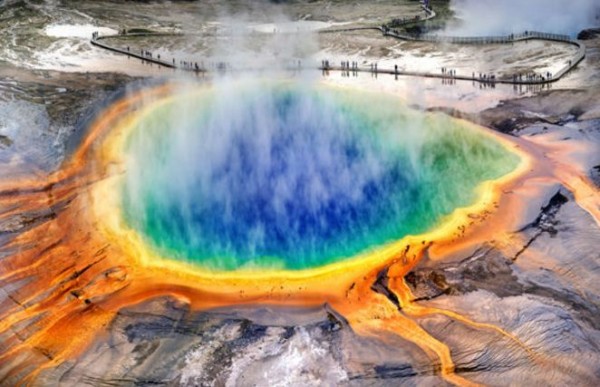Yellowstone Supervolcano Won’t Erupt in 2016 but …
| Arthur Dominic Villasanta | | Jun 19, 2016 08:42 AM EDT |
(Photo : Getty Images) A crater at the Yellowstone supervolcano
The seething Yellowstone supervolcano at the Yellowstone National Park in Wyoming is mathematically overdue for another devastating eruption that might render most of the United States uninhabitable but this won't occur this year as some alarming media reports claim.
The Yellowstone supervolcano is the world's largest volcano and is considered by some studies as the most dangerous volcano in the world. The caldera has a size of 25 miles x 37 miles (40 km x 60 km) and was formed after the last Yellowstone eruption 640,000 years ago.
Like Us on Facebook
Yellowstone's three previous monstrous eruptions occurred two million, 1.3 million and 640,000 years ago.
For the record, however, the United States Geological Survey (USGS) estimates the chance of Yellowstone exploding in the coming centuries is very low.
There's a "but," however. This scenario might change if there's a major earthquake that shifts geological plates close to Yellowstone. The dangerous San Andreas Fault in California is only a few hundred kilometers away.
University of Utah Professor Dr. Robert Smith, who has spent almost all his 40-year scientific career studying the Yellowstone caldera, estimated the odds of the supervolcano exploding in our lifetime as infinitesimal.
"If we were to have another big eruption, it would affect a large area, on the order of several states. But, as I said, that probability is very, very, very, very small." said Dr. Smith.
"In my calculations it's point zero, zero, zero, one percent."
Make no mistake, however. The Really Big One is inevitable. Scientists estimate this could come to pass in about a million years, give or take a few hundred thousand years.
The latest row over an imminent Yellowstone caldera eruption this year was fueled by an amateur YouTube video whose videographer claimed bright flashes he videoed indicate an upcoming eruption.
A few years ago, however, one report noted Yellowstone should have last erupted some 40,000 years ago. That it hasn't should mean the fourth eruption is on its way.
This estimate made in 2015 was based on data showing the floor of the supervolcano has been climbing three inches per year since 2008, the fastest rate since records began in 1923.
"It's an extraordinary uplift, because it covers such a large area and the rates are so high," said Dr. Smith. "At the beginning we were concerned it could be leading up to an eruption."
This evidence, however, doesn't point to an eruption any century soon.
Fears, mostly unfounded, about a Yellowstone eruption reported in 2015 was fueled by news reports that computer simulations showed this catastrophe might occur earlier than anticipated. This nightmarish news forced the USGS to say the scenario outlined by the simulation isn't as bad as had first been predicted.
But here's what might be in store for future Americans centuries from now when Yellowstone does erupt again as predicted.
The supervolcano will hurl lava into the sky for thousands of feet and dump a layer of volcanic ash 10 feet deep up to 1,000 miles away. Most of the U.S. will be covered by a thick layer of ash that will kill most plant life. Scientists estimate two-thirds of the U.S. will become immediately uninhabitable.
Some experts believe the next Yellowstone eruption will be a planet-killing cataclysm that could wipe out practically all life on Earth. Humans will be among the first species to go extinct.
TagsYellowstone Supervolcano, yellowstone national park, united states geological survey, Dr. Robert Smith
©2015 Chinatopix All rights reserved. Do not reproduce without permission
EDITOR'S PICKS
-

Did the Trump administration just announce plans for a trade war with ‘hostile’ China and Russia?
-

US Senate passes Taiwan travel bill slammed by China
-

As Yan Sihong’s family grieves, here are other Chinese students who went missing abroad. Some have never been found
-

Beijing blasts Western critics who ‘smear China’ with the term sharp power
-

China Envoy Seeks to Defuse Tensions With U.S. as a Trade War Brews
-

Singapore's Deputy PM Provides Bitcoin Vote of Confidence Amid China's Blanket Bans
-

China warns investors over risks in overseas virtual currency trading
-

Chinese government most trustworthy: survey
-

Kashima Antlers On Course For Back-To-Back Titles
MOST POPULAR
LATEST NEWS
Zhou Yongkang: China's Former Security Chief Sentenced to Life in Prison

China's former Chief of the Ministry of Public Security, Zhou Yongkang, has been given a life sentence after he was found guilty of abusing his office, bribery and deliberately ... Full Article
TRENDING STORY

China Pork Prices Expected to Stabilize As The Supplies Recover

Elephone P9000 Smartphone is now on Sale on Amazon India

There's a Big Chance Cliffhangers Won't Still Be Resolved When Grey's Anatomy Season 13 Returns

Supreme Court Ruled on Samsung vs Apple Dispute for Patent Infringement

Microsoft Surface Pro 5 Rumors and Release Date: What is the Latest?












